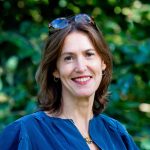LA GUERRE COMMERCIALE DE TRUMP : UN CHOIX ASSUMÉ
Elvire Fabry explique dans une contribution au «Monde» comment les affrontements prioritaires avec la Chine ont perturbé la politique commerciale américaine. Le second mandat de Donald Trump alimenterait davantage son ambition de délocaliser des installations de fabrication aux États-Unis. Les interdictions d’exportation de technologie américaine pourraient pousser Pékin réduire encore sa dépendance à l’égard des importations de technologies étrangères. Cependant, paradoxalement, cela pourrait accélérer la croissance de la puissance chinoise, selon Fabry.

Il faut créditer Donald Trump d’avoir suscité un réveil stratégique des vieilles puissances industrielles face à la Chine. Il obtient sur ce point un soutien transpartisan des Républicains et des Démocrates. Il a poussé les Européens à se mobiliser contre ce qu’ils qualifient désormais de « rival systémique », et a incité l’Australie et d’autres pays à réduire leur dépendance vis-à-vis de l’Empire du Milieu.
Barack Obama avait amorcé ce tournant. Trump l’a accéléré en changeant de méthode. Plutôt que la voie des arbitrages de l’Organisation mondiale du commerce (OMC) où les Etats-Unis ont déposé et souvent gagné de multiples plaintes contre les pratiques commerciales déloyales de la Chine, ou la pression collective d’un accord commercial négocié avec onze autres pays de la région Trans-Pacifique (TPP), Trump a opté pour la voie unilatérale agressive.
Il a réhabilité les droits de douane comme arme de sanction et de chantage pour forcer la négociation. Si Obama avait augmenté les droits de douanes sur 7% des importations de biens chinois, Trump va jusqu’à imposer 70% de ces importations avec, en moyenne, près de 20% de droits de douanes. Ce retour à une politique mercantiliste de réduction massive et systématique des importations, y compris celles qui viennent des alliés traditionnels, a forcé la révision de certains accords (ALENA, Corée du Sud, …) et à en négocier de nouveaux avec le Japon et en particulier la Chine. Les estimations d’impact restent très prudentes sur les bénéfices de ces accords pour l’économie américaine, en particulier le nouveau USMCA avec le Canada et le Mexique. Mais la méthode semble plébiscitée par les indices de bonne santé de l’économie américaine qui à la veille de la pandémie, affiche encore, un taux de croissance du PIB
de 2,4% et un taux chômage de 3,6%. L’accroissement structurel du déficit commercial américain dans le secteur des biens semblait même s’infléchir légèrement.
Cependant cette politique pénalise non seulement les pays qui exportent le plus vers les Etats-Unis, mais aussi les entreprises américaines qui sont désormais exposées à un coût prohibitif d’importation. Pour le seul secteur de la sidérurgie, les Etats-Unis compte 1 salarié qui produit de l’acier pour 80 qui le transforment et pour lesquels cette hausse tarifaire annule les bénéfices de la réforme fiscale menée par Trump. Alors qu’en moyenne, les droits de douanes américains ont été multipliés par trois en deux ans depuis 2018, 84% des exportateurs ont été exposés à l’augmentation du prix de la part de leurs importations dans les produits finis exportés. Tandis que Trump avait fait de la relocalisation de l’emploi manufacturier aux Etats-Unis sa promesse électorale de 2016, le secteur manufacturier s’est contracté de 1,3% en 2019 et les faibles créations d’emplois correspondent à l’accroissement de la population active. C’est le secteur des services qui continue de stimuler la croissance américaine.
Fin 2019 le Fond monétaire international estimait déjà que l’arsenal de mesures tarifaires de Trump et les mesures de rétorsions des partenaires, y compris de l’Union européenne, signifierait – 0,8% de croissance mondiale en 2020 (l’équivalent du PIB de la Suisse). En se détournant des institutions internationales au point de bloquer l’Organe d’appel de règlement des différends de l’OMC, Donald Trump a réduit l’espace de coopération multilatérale et la stabilité des règles à laquelle aspirent les entreprises. Par ailleurs, l’accord avec la Chine est essentiellement transactionnel. Il vise à garantir plus d’exportations américaines à court terme, sans parvenir à limiter la concurrence déloyale qu’exercent les entreprises d’Etat chinoises. Enfin le Budget Office (la commission des finances) du Congrès américain estimait début 2020 que la politique tarifaire de Trump allait réduire le PIB américain de plus de 100 milliards de dollars sur l’année. La répercussion des hausses de prix pour le consommateur américain est in fine évaluée à près de 2000 dollars par an. A présent il reste à évaluer l’impact du
cumul de cette instabilité et de l’incertitude liée à la pandémie.
Cependant, un deuxième mandat de Donald Trump devrait encore renforcer son objectif de relocalisation de la production aux Etats-Unis. Les partenaires seraient soumis à une pression croissante pour s’aligner sur les intérêts américains selon une logique antagoniste, pour ou contre la Chine. Cela devrait contribuer à accélérer le recentrage de l’économie chinoise sur sa consommation intérieure. L’interdiction de l’exportation de certains biens technologiques américains, comme aujourd’hui les semi-conducteurs, pousserait Pékin à réduire un peu plus sa dépendance vis-à-vis des importations de technologies étrangères, en subventionnant plus activement encore le développement de la production nationale. Trump risquerait ainsi tout autant d’accélérer le développement de la puissance chinoise !
Néanmoins, ce n’est pas à l’égard de la Chine qu’il faut attendre une inflexion majeure d’une victoire du challenger démocrate, Joe Biden. Il pourrait se montrer plus ouvert à une coopération internationale, notamment transatlantique, pour tenter de discipliner le capitalisme d’Etat chinois ; mais le désengagement des chaînes de production chinoises resterait de mise (reshoring). En revanche, Biden appelle à subventionner plus activement certains secteurs stratégiques et à être plus offensif sur la restriction de l’accès aux marchés publics pour les entreprises étrangères, au risque de sortir les Etats-Unis de l’accord multilatéral GPA (Agreement on Government Procurement) ; et c’est surtout son engagement en faveur de la lutte contre le changement climatique qui distinguerait sa politique commerciale de celle de Trump. La mise en place d’une mesure d’ajustement carbone aux frontières, qui ferait écho au projet européen marquerait un changement profond car il ferait passer la défense d’un bien public mondial devant « America First ».




